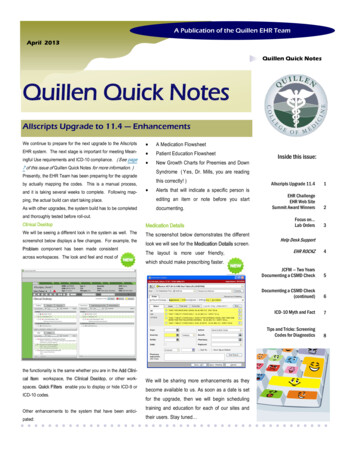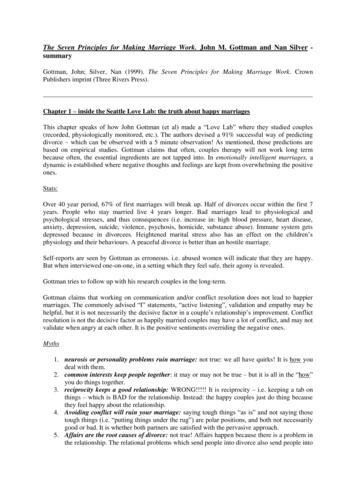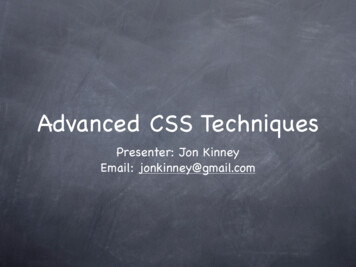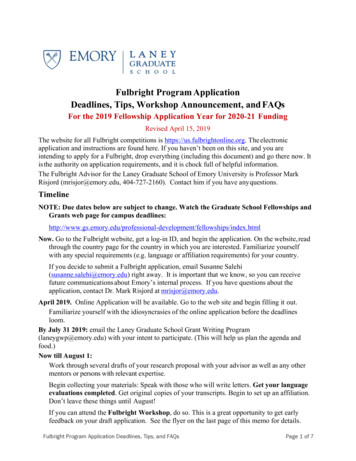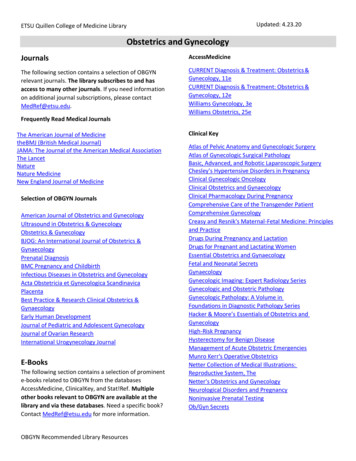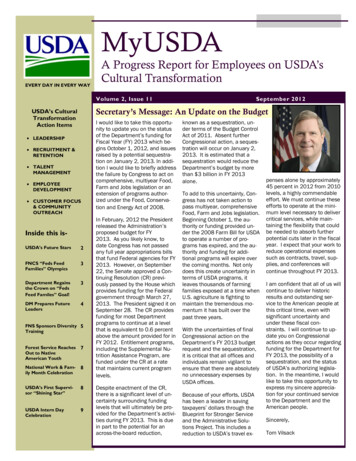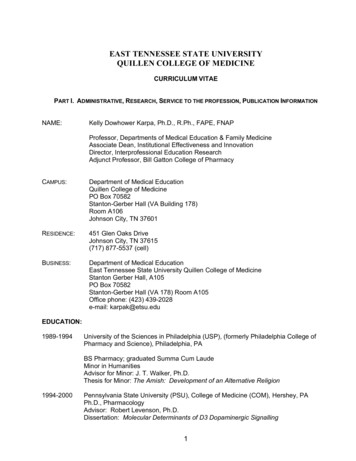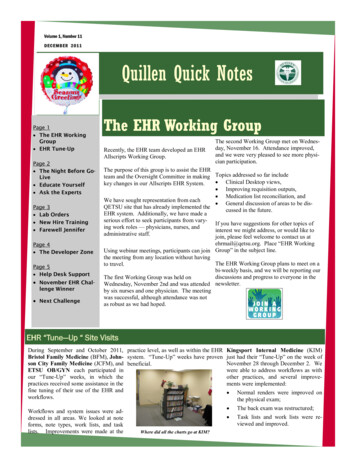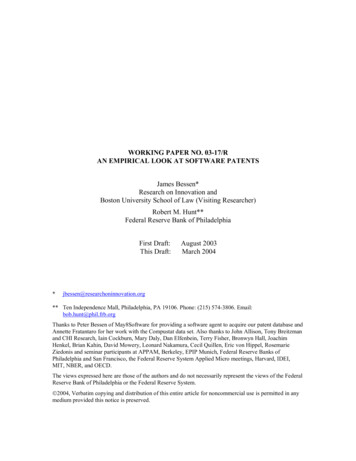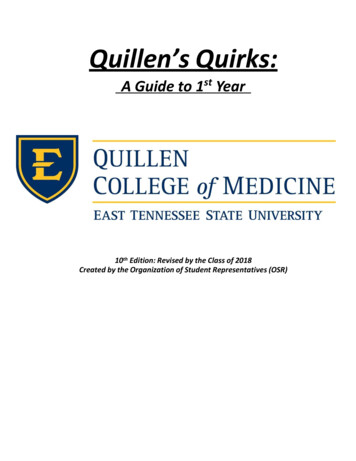
Transcription
Quillen’s Quirks:A Guide to 1st Year10th Edition: Revised by the Class of 2018Created by the Organization of Student Representatives (OSR)
Table of ContentsPageI.How to Study During the First YearII.General InformationIII. IV. First Year Schedule FallSemester CoursesMedical Human Gross Anatomy & EmbryologyCellular & Molecular MedicinePhysical ExamCommunication Skills for Health ProfessionalsCase-Oriented LearningProfession of Medicine SpringV.Semester CoursesPhysiologyCell & Tissue Biology (Histology)Lifespan DevelopmentBiostatistics & EpidemiologyGeneticsVI.More about Books to BuyVII.Study Methods & LocationsVIII.Student PositionsIX.Student Organizations and Interest GroupsX.Community Service OpportunitiesXI.Class BudgetXII.Summer ResearchXIII.Class NotesXIV.Personal Finances HealthXV.InsuranceHealth Insurance-101Health Insurance Options ksOther Useful PlacesXVII. Map of Johnson CityClass CompositesClass of 2016Class of 2017Class of 84888992969799101102103
Welcome to Quillen College of Medicine!Congratulations on entering medical school! You have overcome a huge obstacle.Many challenges still await you, and each of you has the skills and abilities to overcomethem. You also have a unique and significant support system in this school that may bequite different from any that you have encountered so far. The administration, faculty,staff, upperclassmen and your classmates are all valuable assets to you. Everyone herewants you to succeed! This manual has been created to help your transition into medicalschool. Our desire is for you to be as prepared as possible for your courses, and we alsohope to help you avoid some of the pitfalls that those before you encountered.This resource has been compiled by the Organization of Student Representatives(OSR). At Quillen, this organization functions as a liaison between the student body andadministration, promotes camaraderie among the classes, and keeps abreast of studentneeds in order to effect change. It also has the responsibility of representing Quillen to theNational OSR, which is a branch of the Association of American Medical Colleges (AAMC).The AAMC directs much of academic medicine, including medical school licensing and theUSMLE exams. We are here to serve you in any way possible, so please feel free to contactus.If you have concerns about classes, teachers, staff, etc. please contact Dr. TomKwasigroch, Associate Dean for Student Affairs. Together, we strive to make improvementsin any way possible, but we must be aware of issues before changes can be made. For moreinformation about OSR and an online version of this manual you can ide/osr.aspxLindsey Shipley, MS-2Kyle Boden, MS-2President, OSRVice-President, du
I. How to Study During the First YearThe first thing to remember is that you made it into medical school, and despite thefeelings of fear and inadequacy that every one of you will have, you are extremelyintelligent and can make it through medical school. Most of the concepts presented in yourclasses will not be very difficult, but the sheer volume is challenging. You cannot afford toget behind. Unlike college, you don’t have lulls in the semester that allow you time to catchup. This becomes especially true during your second semester.There is no magical way to study. You must find what methods work best for you asan individual. Be flexible; be willing to try new techniques to determine what will be themost beneficial. Upperclassmen are always available and happy to give you information andadvice about professors, classes, etc., but remember that everyone is different, so you haveto identify what is best for you. Below are some of the most common approaches tostudying.You won’t use them all, but these are some methods to consider:Notes: Knowing the notes is the key to success in the first two years of medical school. Weare fortunate at Quillen to have notes provided by the faculty, and this is where nearlyevery test question will come from. But know this: every portion of the notes is fair game,including figures, graphs, and tables. Know them well, and you will do well. Also note thatalthough the notes are provided by the faculty, they are not free. The price can range from 7 to 15 depending on the length of the section and whether they’re colored or not.Old Tests: For several years Quillen has had a policy of not returning old tests, so those thatare available are at least 10 years old. Information covered on old tests my not coincidewith the order in which the material is tested now. It will be made clear to you which examsare “fair game” to use as study resources. Many of the professors are still teaching thesame sections as when old tests were written, and often several questions or ones verysimilar will appear on your tests. More importantly, previous tests can serve as a goodindicator for assessing your areas of weakness, as well as highlighting the recurrent andmost essential concepts to understand.Study Groups: For some people, studying together can be very productive. Group studyingcan be beneficial, especially for Anatomy. Going through Grant’s dissector or the class notesand asking questions of each other has proven helpful for many people. This may also be agood approach for Cell and Tissue. Talking about Kodachromes and using the multi-headedmicroscopes can help in recognizing structures and learning concepts more quickly.Other Common Suggestions: Read or look over notes before class, rewrite class notes,make your own study guides or condensed notes to look at right before tests, write yourown note cards or make/use online notecards (Flashcardexchange.com), use colored pensor pencils, write and draw things out using white boards, get a tutor, use short review
books like the Board Review Series (a.k.a. “Grid Books”), which are good for samplequestions and emphasizing the “must know” material, or use online resources for practicequestions or tests from other schools.The bottom line and the most common advice you will hear is this: don’t let yourself getbehind. Try to be organized, manage your time wisely, and keep up with the material as it ispresented. Although the amount of material will seem overwhelming at times, rememberto take it all one page, one lecture, and one day at a time. You will be surprised by howmuch you can and will (and must!) learn.
II. General InformationWhat to Buy and What Not to Buy: Laptops: Laptop computers are now required for all incoming students. If you havequestions about specifications, the IT folks will probably be able to serve you best.Many students have no problems with their Apple computers even though ITdiscourages Apple ( 60% of our class uses a Mac). Virtually every exam you will takenext year is given in a secure online format. The standardized Shelf exams are alwaysadministered in an online format. Many students found tablet PCs or iPads to beparticularly handy for in-class note taking, but it should be noted that some of themwere not compatible with testing software. The type of laptop you buy is completelyup to you, so feel free to ask other students about their preferences. It's helpful toknow that there is a sales tax holiday in Tennessee. You can buy a computer tax-freeif it costs 1500 or less. See http://www.tennessee.gov/revenue/salestaxholiday/ formore information. iPads: Every dissection group has its own personal, mounted iPad that can be usedfor the groups Atlas, Clinical Case Presentation, Web Access for accessing coursedocuments, image capture and note taking to record material for the Cadaver CasePresentation. Anatomy Apps are available on every dissection group's iPad. Thesecurrently include Netter's Atlas, Visible Body, numerous radiology apps for crosssectional anatomy references, quizzing applications, and clinical referenceapplications. However, these iPads can’t be removed from the lab. Some students inthe class of 2018 found having a personal iPad helped them streamline theirstudying ( 60% of our class owns a iPad). Diagnostic Equipment: For the Physical Examination class, it is recommended by thefaculty that every student purchase a diagnostic kit. Representatives from WelchAllyn and Littman will be available during orientation to offer their products. Pleasesee below for bookstore information, online prices of diagnostic equipment from therepresentatives. Before orientation, you are encouraged to consider how you will goabout financing these purchases; students in the past have felt rushed intopurchasing this expensive equipment. Don't forget you'll be buying books aroundthis time too. Very few students in the class of 2018 purchased an ophthalmoscope( 15). During your physical exam course, these will be made available to you.Diagnostic Kit – A few options to consider (These diagnostic kits are not required, butare useful to own if you’re in the Rural Track program or doing mission trips):Standard ophthalmoscope head vs. the PanOptic. The PanOptic ismore expensive, but provides a better view of the optic fundus. Ifyou opt to use only the PanOptic, you will be doing yourself adisservice, however, as most offices, including hospitals, still use thestandard head. The PanOptic is a luxury, and it is recommended
that you familiarize yourself with both models.Grip/Battery Pack: This is truly a personal choice. The lithium gripsare smaller and lighter. They can only be charged by plugging theminto the wall, but they charge faster and don’t have memory. TheooooNiCad battery grip is larger and heavier, but it is cheaper. Also it canrun on two C batteries in addition to the battery pack, so if you planon practicing in developing countries, this is probably the grip youwant to purchase.Stethoscope – This is the must-have piece of equipment. For quality ofsound, you should purchase a cardiology-level stethoscope. The mostcommonly used brand by students seems to be Littmann (Cardiology III,Classic II S.E.).Pen light – These are made available for your use by the Physical Examcourse, so you don’t have to buy one unless you want one for yourpersonal use.Blood Pressure Cuff – These are also provided for you, so there is no reasonto purchase one unless you just prefer to have your own.Snellen eye chart, tuning fork, reflex hammer (a heavy one). These itemsare also optional. A Snellen chart may be included with the purchase of adiagnostic kit. Anatomy Equipment:o Old/ cheap scrubs: Most people in lab choose to wear old or inexpensivescrubs, or something you don’t care about getting dirty and smelly. Somepeople want to wear a plastic apron over their clothes or scrubs. You canbuy aprons at the bookstore.o Gloves: Preferably, you should purchase non-latex gloves because are somefaculty members and other students with latex allergies. There are cheaperplaces than the bookstore to buy gloves (e.g., Wal-Mart or most drugstores).o Lab Coat and Goggles: It is an OSHA requirement to wear goggles. A lab coatis not a necessity, but some students prefer to wear one. To save on cost,some students choose to wear an old long-sleeve shirt. Changing into oldpants or scrubs is a personal preference. Each of you will have a lockeroutside the anatomy lab, where you can keep your ‘lab clothes.’o Scalpel Blades: Start off by buying at least four. The bookstore always hasmore if you need them. These are very inexpensive. Textbooks: Every textbook required for a course and most of the recommendedones are on reserve in the Library. Aside from the ones listed below in coursedescriptions, we recommend that you refrain from purchasing every single book onthe list, as most of them you will open once or not at all. Information about which
books to purchase is included with the discussion of each course. Something to become familiar with are “grid books or BRS books”. They are BoardReview Series book on medical school courses, known as grid book for thecharacteristic grid on the front. Many students find these helpful to go through asthe course progresses and they are good review books for the shelf and boardexams. Even though it is convenient to buy all your books at the bookstore, don’t assumethey have the best prices. If you plan ahead and know which books you aredefinitely going to use, Amazon is a great place to find better prices. Your Big Sib willmost likely give you a few books for your first year.Clothing:Come prepared to dress professionally. You will be required to dress professionally acouple of times a week during the first year, as well as during orientation. Composite pictureswill be taken on the first day of orientation. Men are required to wear a SUIT and TIEand women are to dress accordingly.Big Sib/Lil Sib – Peer Advisement Program:The Big Sib/Little Sib – Peer Advisement Program - was established to pair eachincoming MS-1 with a MS-2 mentor. Each student will be matched with a Big Sib in the summerbased on personality and common interests. The goal of this program is to provide the MS-1swith an MS-2 whom they can build a relationship with and look to for advice on classes, whatbooks to buy, what apartments to rent, etc. Since the MS-2 just finished their first year ofmedical school, they have the most recent experience with changes that have been made atQuillen. Some MS-2's choose to pass on books and old practice tests to help with classes. Thisrelationship can be very beneficial throughout the year as it is always nice to know that youhave someone you can count on for advice and help through the year.General Resources that Are Beneficial: First Aid for Step 1: You will probably want to wait until January, when the newedition of this book is released. It is a helpful in studying for the Physiology Shelf andseveral of the Shelf exams in your second year. Also, this is a resource that you willuse in studying for Step 1, and it is good to become familiar with it early. You don’tneed to buy the new edition that will come out before your Step 1 Exam. Stedman’s Dictionary: In the past, the AMA gave this book out as a sign up gift, butdon’t join any organization just for the bonuses. You can always buy a Stedman’s onyour own. It is a resource you will use throughout your medical education and careerbut don’t feel pressured to buy one at this time.
Diagnostic Kit Pricing Information:Vendor sales – Representatives from Welch Allyn and Littman will visit during orientationand offer you the option to buy a diagnostic kit, a stethoscope, and other medicalequipment that day. If you choose to buy from the vendors, you will likely get a pretty gooddeal on well-recognized brands. They offer reduced prices to incoming students. Theinternet is also a useful shopping center. The following is a list of prices of Welch Allyn fromwww.themedicalstore.biz (website used by most in our class).Regular Diagnostic Kit NiCad Handle 504.00 Lithium Ion Handle 605.00 PanOptic Kit NiCad Handle 651.00 Lithium Ion Handle 748.00Neebo’s (ETSU Quillen Bookstore)824 West Walnut StreetPhone 423.926.0833Email: rbrundige@nebook.comThe bookstore will have a sale on select items at the beginning of classes. The storewill be open the Friday of the White Coat Ceremony. Additionally, the bookstoreoffers a member card program, which awards 5 of store credit for every 150spent. Textbooks are sold free of tax. Please call or email the store with anypurchasing or ordering questions, as they will order specialty items upon request.The following prices are accurate as of May 6, 2014:Bookstore – contact Bob Brundige (rbrundige@nebook.com) for the most up to datepricesLittman Cardiology III Stethoscope 180.00Littman Master Cardiology Stethoscope 220.00Pocket Diagnostic Set with Hard Case 266.00Taylor Hammer 2.95Eye Chart 2.50Tuning Fork 10.70Basic Blood Pressure set 35.00Shelf Exams:Shelf exams, which serve as your final exam in most courses, are created by theNational Board of Medical Examiners (NBME), the same organization that creates theUSMLE Step exams (i.e., “Boards”). These exams often employ old Board questions, which
are very clinically oriented. As you will hear from the faculty many times throughout theyear, the best way to study for these exams is to study hard and do well in the classes. Thenotes are voluminous and time-consuming, and so many study for the shelf from a BoardReview Book (often referred to as “grid books” because of the grid pattern on the front ofall Board Review Series books). The bookstore has a wide array of these. The ones werecommend will be discussed with each course. It is best to buy these books early in thecourse and familiarize yourself with them throughout the course.Curriculum Vitae (CV):A Curriculum Vitae is essentially a resume, and you will be required to submit one toresidency programs. Your CV acts as a vehicle to record your extracurricular activities andachievements, and includes items such as activities, community service, honors, researchexperiences, etc. You should start working on it early in your medical career and add to it asyou participate in more activities. The Career Exploration class requires you to start your CVand submit in the drop box, and you will need it when you talk with Dr. Daniel Wooten aboutyour career choices. If you put it off, it may prove difficult to remember all the activities inwhich you were involved when you start applying for residencies, so the best advice is tostart it as early as possible in your medical school career. The Career Exploration webpageon D2L contains links to sample CV’s, or you can search “Curriculum Vitae” to find otherexamples.
III. First Year ScheduleFall Semester:Block 1 – 11 weeksHuman Anatomy & Embryology Intro toPhysical ExamBlock 2 – 9 weeksCellular and Molecular Medicine FullSemesterCommunications (Every other Thursday. Starts in August and lastsuntil December.)Spring Semester:Block 1 - 12 weeksPhysiology Cell &TissueLongitudinal and Week-long PreceptorshipBlock 2 - 5 weeksBiostatistics & EpidemiologyLifespan Development MedicalGeneticsYear-Long Courses:The Profession of Medicine: Physician, Patient & Society (DuringOrientation week and selected dates in the Fall and Spring)Case-Oriented Learning(Meets once a week on Thursday mornings)Career Explorations(Meets only three times during the year) M1 academic schedules can be found on QCOM’s website under Academic info/education/m1curriculum.aspx
IV. Fall Semester CoursesFlipped Classroom ApproachJust starting in the fall of 2013, certain courses at Quillen began utilizing the “flippedclassroom” approach while teaching in the classroom. Flipping the classroom requires thatstudents watch either lecture recordings or podcasts before the material was presented inclass the following day. For example, you would watch and preview Tuesday’s lecturematerial on Monday night. On Tuesday, lecture would be abbreviated and the professorwould only touch on key concepts and answer any questions that students had. A shortgroup quiz was given at the beginning of class, especially during Anatomy and Cellular andMolecular Medicine. Therefore, it is important to preview the material so that you cansucceed on the quizzes. The idea behind flipping the classroom comes from giving studentsan opportunity to preview information before it’s presented. This helps students seematerial twice instead of just a single time. Theoretically, this helps to improve retention.Also, in Anatomy, flipping the classroom was aimed to enable students to spend less time inlecture and more time in lab. The courses that utilized the Flipped Classroom Approachwere Anatomy and Cellular and Molecular Medicine.How effective is the "Flipped-Classroom"?Answered: 104 Skipped: 0
Did you like the "Flipped-Classroom" Approach?Answered: 104 Skipped: 0In the courses where the "Flipped-Classroom"approach was fully utilized, how often did you actuallypreview the material?Answered: 104 Skipped: 0
In general, how much time did you spend previewingmaterial before lecture in the "Flipped-Classroom"courses?Answered: 104 Skipped: 0Do you feel like you have retained more knowledgefrom "Flipped classroom" courses vs. "TraditionalStyle" courses?Answered: 104 Skipped: 0
Recorded LecturesAnother aspect of Quillen education is that a lot of the lectures are being recorded. Withthe “flipped classroom” aspect for Anatomy and Cellular and Molecular Medicine, all lectureswere prerecorded so that students can preview the material. Dr. Monaco in Cell and TissueBiology made free podcasts on iTunes which covers all lecture material. A lot of students choseto listen to these instead of attending class because there are no in class quizzes in Cell andTissue (it is not a “flipped classroom” course). Some lectures for Physiology and Genetics (alsonot flipped classroom courses) are recorded. Because each student learns differently, werecommend coming to all classes at first, and then later choosing which approach to take. Notethat most of the lectures can be sped up, but the quality of the recorded video lectures isn’talways the best.Medical Human Gross Anatomy & EmbryologyThis will be the most challenging and time-consuming course during your first semester.The material progressively becomes more difficult with each section, but over time, youlearn how to study more effectively. There is an incredible amount of information packedinto this 11 week course and it is crucial to keep up with the material as you go. The flippedclassroom approach will help with this. You will take the first exam (embryology) within twoweeks of starting school, which will allow you to gauge the efficiency of your studymethods. The faculty is willing to help you and you should feel free to ask questions,especially to gain clarification in the lab.With the Flipped Classroom, the aim is to spend less time in lecture ( 90 minutes) and moretime in lab ( 2 ½ hours). For lab you will need scalpel blades, at least one box of nonlatex/nitrile gloves, and a pair of old clothes or scrubs and old shoes. Inexpensive scrubsare available at Wal-Mart or other retailers. You will be assigned a locker near the lab, soyou may change into scrubs or old clothes for lab, then change back into your regularclothes before your next class.Embryology will be taught the first two weeks by a guest lecturer, Dr. Sadler. He is theauthor of the Medical Embryology text you will be using for the course. This is a realprivilege. His text is the most commonly used among medical schools in the country.Although embryology will be taught the first two weeks and will be focused primarily onlyon the first exam, it will be incorporated into the rest of the course. It is VITAL to get agood grasp of embryology, as it will be helpful to you in other courses (such as Genetics,Physiology, and Cell and Tissue) during Spring Semester.
Faculty:Dr. Thomas Kwasigroch“Dr. Kwas”Course Directorkwasigo@etsu.eduDr. Richard Feitfeit@etsu.eduDr. Caroline Abercrombieabercrombie@etsu.eduDr. James Denhamdenham@etsu.eduHow to Study for the Course:o Lecture: It is important to know every detail included in the lecture handouts. Thefact that a point was not emphasized in class does not mean that it will not be on anexam. Reviewing old exams will give you an excellent indication of how effectivelyyou have been studying. There is a group quiz before every lecture that will highlightmain points/concepts/“body parts”. This is where previewing the lecture material isimportant! The quizzes usually require identifying images taken from Netter’s or mayinclude clinical vignettes that require you to apply information from the notes. Thequizzes are given in a group format, and you may work with the members of your labgroup. Besides helping you prepare for exams, quizzes may also improve you overallscore; if you do well, your quiz average can bolster your final grade. The BRS reviewtests are also very helpful for this course.o Test: There will be one test per section. The sections are Embryology, Back &Thorax,Head & Neck, Abdomen & Pelvis, and Extremities. The test will be split into apractical and a written exam (Embryology is just a written exam). The practical willbe taken in lab with each student at a station for a timed period to answer twoquestions about 2 structures tagged. You will rotate around to each station when atimer goes off. It may seem intense that you are timed at your station but do notworry. There is plenty of time at each station to identify the structure and answerthe questions. The best advice is to orient yourself and relax when you approach astation. You will have studied hard. Be confident and remain calm. The other portionof the exam is a written part that is taken online with a lockdown browser.o Lab: The lab is typically closed the day before tests so that the faculty can set up theexam. Otherwise it is open for students’ use at any time of the day. To make bestuse of your scheduled lab time, it is helpful to look ahead and be somewhat familiarwith the dissection you are to do that day in lab. The professors are present duringthis time and are able to answer questions. Make sure the lab is clean before theyclose it, as you don’t want them to have to clean up before they set up the exam.o Know your own cadaver very well, but also study other cadavers, asstructures do appear differently in different dissections. Be courteous when
using others’ cadavers. Don’t shred someone’s dissection, and always spraythe bodies with diluted preservative before recovering so they don’t dry out.Spraying the cadavers is to your benefit! The dissections look much better forthe exam if they aren’t dried out.o If a cadaver in the lab has an anomaly, make sure to look at it becausethese structures may appear on exams. Your class may choose to keep arunning list of any good examples of structures or irregularities on one of thewhite boards in the lab.o Study in groups in the lab, even if you generally do better studying alone. Itforces you to think through what you are looking at, which you will have todo on the test. Friendly “pimping” of each other over minute points you havediscovered in the notes and dissector may also pay off. The prosected cadaver(dissected by the faculty) will provide good examples of the structures for youto look at.o If there is a structure that no one in the class has dissected, it is very likelyto appear on the exam. The professors do extensive dissections the daybefore the exams and may dissect out items to include on the test.o Old exams: Items that appeared numerous times on old practical exams arelikely to reappear on yours. The relative orientation questions are also verybeneficial to work through as these can be fairly difficult.o Practice practicals: The second-year class will set up one of these before yourfirst test. Your class will be responsible for setting up the others. These areusually organized by the class secretary and held the evening before the labis closed. Good practice questions require identifying structures andanswering questions about them on the cadavers, x-rays, models and crosssections. This session is one of the best preparations for the lab exam; itprovides one last review of the structures and allows you to assess yourperformance before the lab closes.How to Study for the Shelf:o Due to the volume of detail, it is important to learn the material thoroughly as yougo. Don’t wait until the end of the block to start learning details!o Study a Gross Anatomy review book. The Gross Anatomy Board Review Series Book(Grid Book) provides an excellent review. Be sure to pay particular attention to anyclinically relevant information in the BRS. You can skip the extremities sections as youwill have just taken an exam on that material. The Head and Neck section is notgenerally emphasized on the Shelf. The NBME website gives a breakdown of howmany questions are expected to come from each section of the Gross Anatomycourse.Books to Buy/Not to Buy:Essential:o Either Netter’s or Grant’s: Your personal preference determines which oneyou should use. Most pictures used in class PowerPoint lectures and on thequizzes come from Netter’s. Cross-referencing your class notes with pictures
from an atlas is an excellent way to study the material. Netter’s was definitelythe most preferred book in our class.o iPad Apps: Some of you may choose to purchase the Netter’s and/or VisibleBody Apps instead of the Netter’s or Grant’s textbooks. Most students withtheir own iPads chose this route.Recommended:o Color Atlas of Anatomy: This has pictures of actual dissections. It is a veryhelpful resource throughout the course, but especially the night beforethe exam when the lab is closed and you are unable to look at a cadaver.o Netter’s Flashcards: These provide you with Netter’s images and allowsyou to ID anatomical parts with answers on the back of each card.o Rohen’s Flashcards: These cards have actual pictures of dissections,which are very beneficial to supplement your studies in the lab.Optional:o Buy both Netter’s and Grant’s: There is a fair amount of overlap, but each hasits strengths and weaknesses. You may find it helpful to have both.o There are “grease” copies of Grant’s Dissector in the lab, but you might find ituseful to buy a personal copy for previewing or reviewing dissections.o Clinically Oriented Anatomy: Most of the pictures in this book are also foundin Grant’s. It has some helpful tables and diagrams of muscle attachments.The clinical discussions in the blue boxes can be interesting and useful.o Acland’s Anatomy Videos: This guy has the best dissections known to man! Thereare DVD’s of him talking through real prosections in the medical library. Hisprosections are literally perfect. Although a bit lengthy, you will know themate
most essential concepts to understand. Study Groups: For some people, studying together can be very productive. Group studying can be beneficial, especially for Anatomy. Going through Grant [s dissector or the class notes and asking questions of each other has proven helpful for many people. This may also be a good approach for Cell and Tissue.
